Cologne is one of the oldest cities in Europe, located in the western part of Germany. It is a harmonious blend of medieval architecture and modern buildings, with ancient cobblestone alleys and bustling neighborhoods filled with nightclubs, democratic beer bars, and upscale restaurants. This city embraces the benefits of modern civilization while preserving its rich history. If you are interested in exploring Cologne, its landmarks, and interesting attractions, please refer to our comprehensive guide.
Cologne Cathedral
The majestic cathedral is the most significant architectural landmark of the city and one of the tallest churches in the world. It houses several important relics, including the Hero Cross with a very realistic depiction of Jesus, a wooden statue of the Virgin Mary, and a golden reliquary containing the remains of the Three Holy Magi.

Ludwig Museum
In 1969, industrialist Peter Ludwig and his wife Irene donated a rich collection of art to Cologne. This collection became the foundation of the Ludwig Museum, which was opened in Cologne in 1977. The collection was later expanded with paintings owned by lawyer Josef Haubrich. As the collection grew, a new building with a total exhibition area of 8,000 square meters was provided in 1986.
The museum’s halls feature a vibrant display of surrealism and German expressionism, as well as pop art and graphic art. The museum showcases works by Salvador Dalí, Jasper Johns, Joan Miró, and includes 90 diverse pieces by Pablo Picasso. Additionally, the museum houses the world’s largest collection of cameras and photographs.

In addition, the Ludwig Museum hosts 8-10 large-scale temporary exhibitions every year. For example, the exhibition “Ukrainian Modernism 1900-1930 & Daria Koltsova” is a prime example of how Russia’s war against Ukraine is changing the perception of the “Russian Avant-Garde.” This is because many artists who were previously grouped under this term lived and worked in Ukraine, immersed themselves in the centuries-old Ukrainian culture and its landmarks. Alexandra Exter, Alexander Bogomazov, Vladimir Burliuk, and Vasily Yermilov are represented in the Ludwig Museum’s collection. They lived in Kyiv, Odessa, and Kharkiv, where they had their own studios. The exhibition on Ukrainian Modernism showcases approximately 80 works created between 1900 and 1930.
- Address: Heinrich-Boll-Platz, 50667 Koln, Germany
- Website: https://www.museum-ludwig.de/
- Working hours: Tuesday to Sunday, 10:00 a.m. to 6:00 p.m., Monday is a day off, and every first Thursday of the month, 10:00 a.m. to 10:00 p.m.
- Children and young people under 18 can enter for free. Adult tickets cost 11 €.
Chocolate Museum
This place is a great example of what people of all ages can see in Cologne.
This is the first chocolate museum in the world, and it has inspired similar pavilions in other countries. In 1993, the local company Imhoff-Stollwerck, which has been producing chocolate since 1839, opened the museum. A 2,000-square-meter building with a unique architecture was constructed specifically for the museum on the banks of the Rhine. The building resembles a real ship.
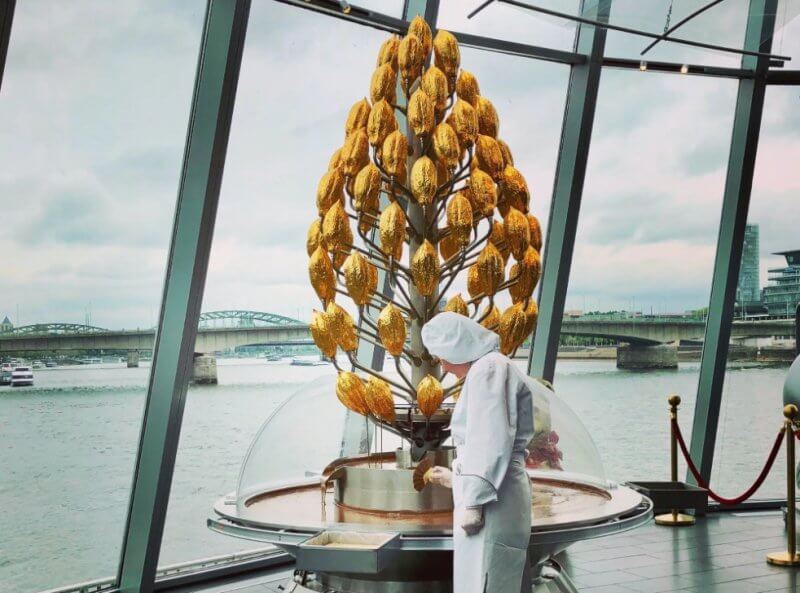
In the lobby, visitors are attracted by an unusual fountain: liquid chocolate rises to a height of 3 meters. You can even try this chocolate by dipping a sweet waffle into it.
An important museum exhibit is located behind a glass wall: a fully computerized mini-factory. Visitors can not only watch the entire chocolate production process, but also taste the resulting product.
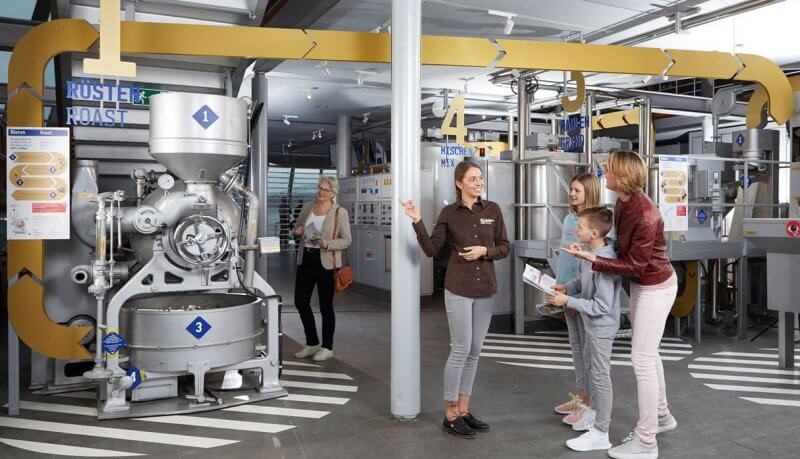
Another unusual attraction is a greenhouse with an area of about 100 m² for growing plants that are used in the chocolate-making process. The greenhouse maintains a tropical microclimate with a temperature of +20…+30 ºC and a humidity level of 100%.
The halls of the second floor are filled with exhibits that tell the story of chocolate from the time of the Aztecs to the present day. Visitors can see packaging from different years, chocolate candy vending machines, and special utensils for making chocolate.
- The pavilion is located at the northern end of the Rheinauhafen promenade. Address: Am Schokoladenmuseum 1A, 50678 Koln, Germany
- Website https://www.schokoladenmuseum.de/
- Working hours: Tuesday to Sunday, 10:00 a.m. to 6:00 p.m.
- Children under 6 years old can enter for free. Other visitors must purchase a ticket, which is more expensive on Saturday and Sunday. Adults pay 14.50 and 16 euros, children under 18 pay 8.50 and 10 euros, and students pay 11 and 12 euros.
Zoo
The Zoological Garden of Cologne was founded in 1860, and it currently houses almost 10,580 animals from 842 species.
The zoo has an interesting feature: most of the enclosures are designed without cages or grates, and the animals are limited by natural obstacles. The llamas live behind a shrub, the grizzly bears live behind a pond, the cheetahs live behind a mound of rocks, and the lions and tigers live behind a fence made of sturdy glass.
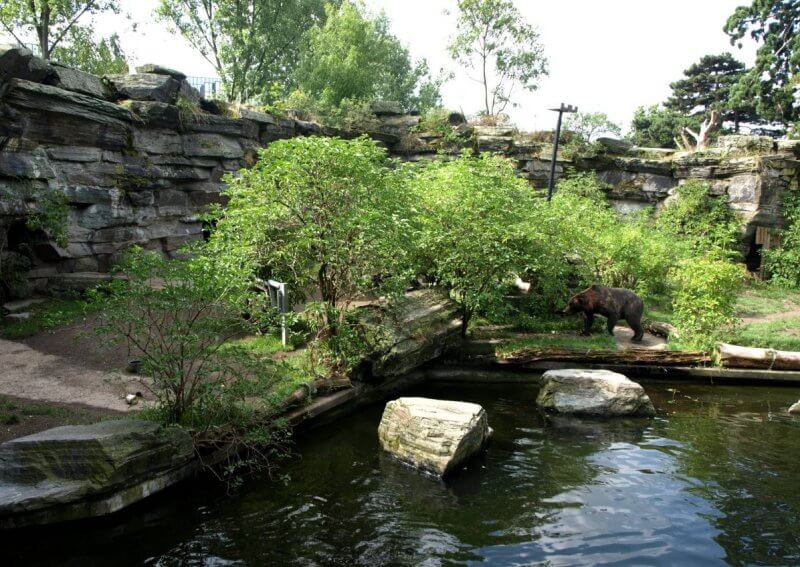
Tourists usually show the most interest in the following areas of the zoo:
- The Hippopotamus House, where hippos, antelopes, and Nile crocodiles live.
- “Aquaterrarium” with aquatic creatures from different parts of the world.
- The Jungle House, where gorillas and orangutans live.
- “The House of the Tropical Jungle” with rainforests and exotic animals.
- “Suricates”, where otters also live.
- A terrarium with exotic reptiles and amphibians.
- “South America” is home to anteaters and other animals from Latin America.
A feeding schedule has been compiled especially for those who want to watch the animals eat.
- Address of the attraction: Riehler Str. 173, 50735 Koln, Germany
- Website: https://www.koelnerzoo.de/
- From March 1 to October 31, the zoo is open from 9:00 a.m. to 6:00 p.m. From November 1 to March 1, it is open from 9:00 a.m. to 5:00 p.m.
- Children under 3 years old can enter for free. Other visitors need to buy a ticket to see the zoo’s inhabitants: 23 € for adults, 11 € for children 4-12 years old, and 17 € for students.
https://translated.turbopages.org/partner/v2/?template=horizontal&partner=kuku&order=top&num=3&features=logo&script_id=tripster-widget-631511&version=2&siteUrl=https%3A%2F%2Ftranslated.turbopages.org%2Fproxy_u%2Fru-en.en.8d621711-68bd88cc-dbdc9987-74722d776562%2Fhttps%2Fkuku.travel%2Fcountry%2Fgermaniya%2Fgoroda-i-kurorty-germaniya%2Fkyoln%2Ftop-11-dostoprimechatelnostej-goroda-kyolna%2F
Flora Botanical Garden
All of Cologne’s parks offer picturesque landscapes, but the most popular attraction of this kind is the Flora Botanical Garden, which was established in 1864.

The entire area is fully landscaped and divided into several themed zones. The park features a Mediterranean Garden, an Aroma Garden, and a Farm Garden with agricultural crops. There are also several indoor greenhouses with a rich collection of cacti, camellias, and other plants. The small Alpine Garden is home to around 2,000 mountain herbs, flowers, and shrubs. The natural lake, adorned with a statue of Neptune, is home to not only frogs but also turtles and ducks.
The garden has many paths, sculptures, fountains, and recreation areas. There is also a cafe called Flora with a wide menu and affordable prices.
- Main entrance to the park: Alter Stammheimer Weg, Cologne Riehl
- Website: http://freundeskreis-flora-koeln.de/
- The garden is open from 8:00 a.m. until dusk (maximum until 9:00 p.m.). The subtropical greenhouse is open from 10:00 a.m. until 4:00 p.m. in winter and until 6:00 p.m. in summer.
- Admission to all areas of Flora and the Subtropical Greenhouse is free.
St. Martin’s Church
Among the residents of Germany, this church is better known as the Great St. Martin. The church was founded in the 10th century, and throughout its history, it has been destroyed by fire and rebuilt many times. The last time it was destroyed was during World War II, and it was even considered to be left in this state as a monument to the victims of Nazism. However, in 1948, the Great St. Martin was rebuilt, and the work was completed in 1985.
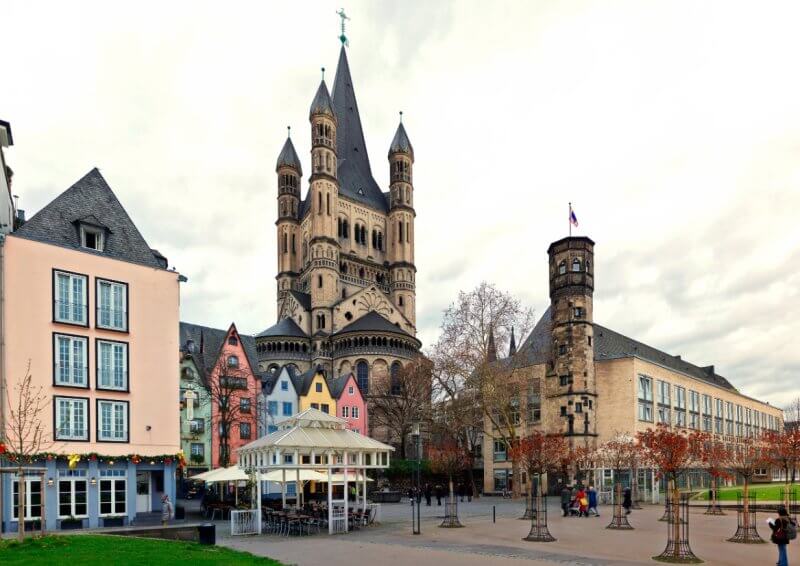
The main attraction of St. Martin’s Church is a fragment of an ancient column that stands in front of the entrance.
The interior features unique vaulted ceilings and stained glass windows.
- Address: An Gros St. Martin, 50667 Koln, Germany
- The church is closed on Mondays and Tuesdays. On all other days, it is open from 2 p.m. to 5 p.m.
- You can enter the building and see the interior for free.
Hahnentorburg
The Hanentorburg is one of the many attractions in Cologne that history enthusiasts will find interesting to explore.
These are the western gates of the medieval defensive city wall, which have been preserved as well as the Eigelstein Gate, the St. Severin Gate, and the Ulrepfort. Taken together, these structures provide a comprehensive view of the fortification capabilities of Cologne’s city walls.
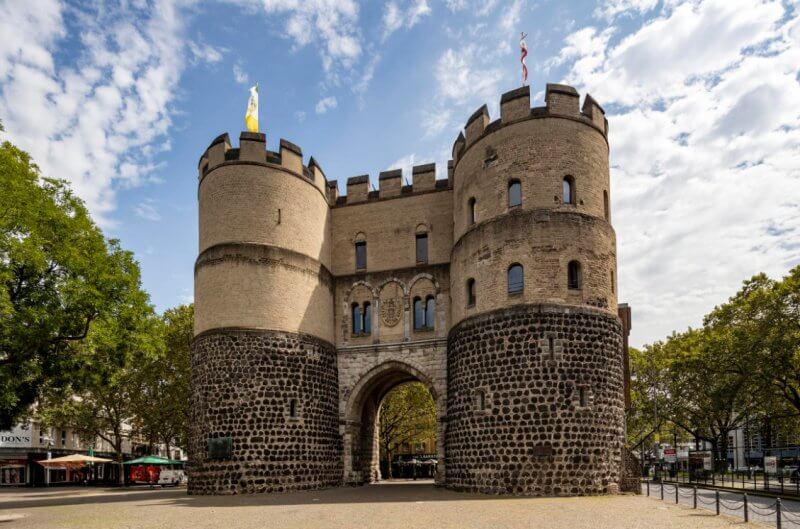
The exact time of construction of the Hanentorburg Gate is unknown, but historians have determined that
They already existed at the beginning of the 13th century. The Holy Roman Emperors entered Cologne through them, after their coronation in Aachen, to Cologne Cathedral to venerate the relics of the three Holy Magi. Since 1988, the building of the gate is occupied by the headquarters of the honor guard of the Carnival of the city of Cologne.
- Address of the attraction: Rudolfpl, 1, 50674 Koln, Germany
Perfume Museum
In 1708, perfumer John Maria Farina founded a perfume manufactory in Cologne – today it is the oldest perfume factory in the world. It was there that the legendary cologne (Eau de Cologne translates as “Cologne water”)was invented
Today, the Farina House houses a perfume museum and a perfume factory with a store.
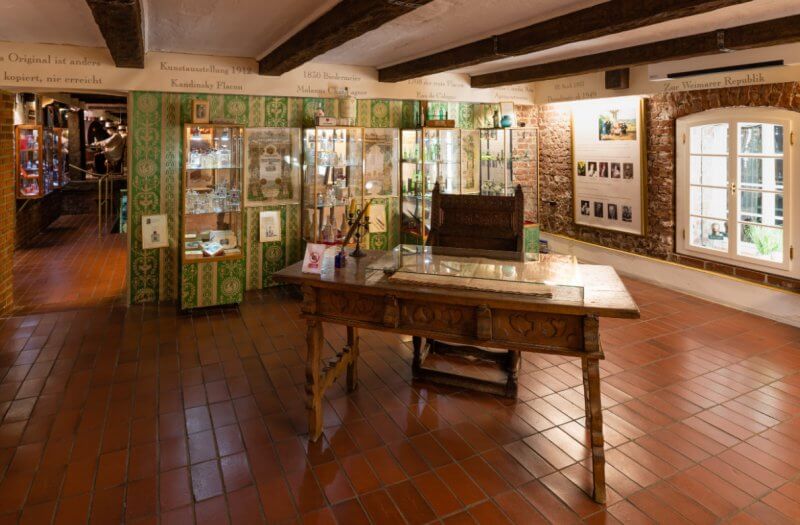
Visitors can see distillation apparatuses for making perfume, photos and paintings depicting technological processes, and a variety of bottles. In addition, they can admire dishes and cutlery, furniture, paintings by famous artists, and many other items that were part of the exquisite furnishings of the Farina House.
- Address of the attraction: Obenmarspforten 21, 50667 Koln, Germany
- Website: https://farina.org/impressum/
- Farina House is open for visits from Monday to Saturday from 10:00 to 19:00, and on Sunday from 11:00 to 17:00.
- You can only visit Farina’s house as part of a guided tour. The tour lasts 45 minutes and starts every hour from the time of opening. The last tour starts one hour before the museum closes. The number of seats in each group is limited, so it’s best to purchase tickets online in advance.
- On Saturday and Sunday, as well as on Thursday at 17:00, the museum offers only historical tours for 12 € per person. From Monday to Friday, regular tours are available for 8 € per person.
Rheinboulevard Embankment
In July 2015, the mayor of the city of Cologne cut a symbolic ribbon and opened the new Rheinboulevard promenade with 500-meter-long steps for public access. Since then, the Rheinboulevard promenade has become a popular attraction for both locals and visitors. This is a nice place by the river, where you can take a leisurely walk and relax on the benches, spend time actively on the running and cycling trails, and enjoy the postcard-worthy views of the Old Town and the cathedral, the Rhine River, and the Hohenzollern Bridge.

Apostolic Church
This 11th-century church will appeal to fans of the Romanesque style in architecture. It is an original three-cone complex with two flanking eastern towers and one western tower. It is largely due to the western tower that this church has become a famous landmark in Cologne, Germany: it is the third tallest (67 m) of all the Romanesque churches in the city. Another notable feature of this church is its beautiful stained-glass windows depicting the 12 apostles.
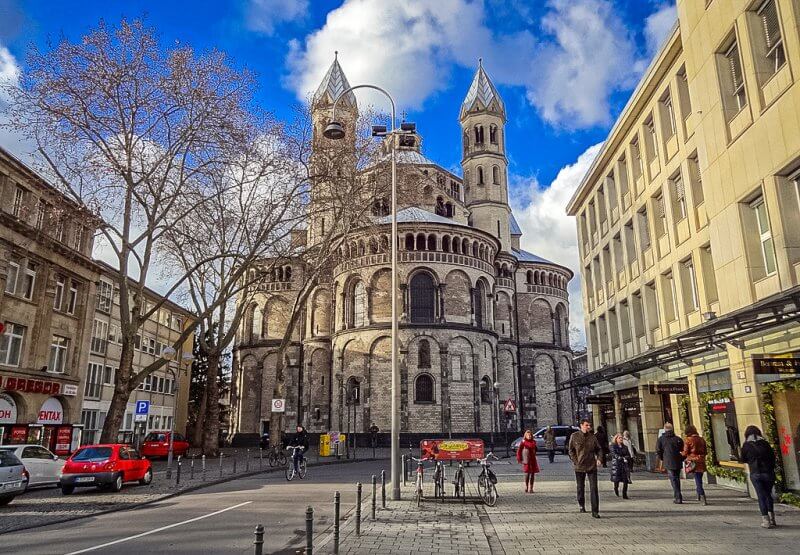
- Address of the attraction: Neumarkt 30, 50677 Koln, Germany
- Website: https://www.st-aposteln.de/start/
- You can view the interior on Saturday from 9:00 a.m. to 7:00 p.m., on Sunday from 8:30 a.m. to 7:00 p.m., and on all other days of the week from 9:00 a.m. to 8:00 p.m.
Augustusburg and Falkenlust Palaces
Not far from Cologne, in the small town of Brühl, there is a landmark that was added to the UNESCO World Heritage List in 1984. This unique complex consists of the Augustusburg Palace, the Falkenlust Hunting Castle, and the adjacent English landscape park.
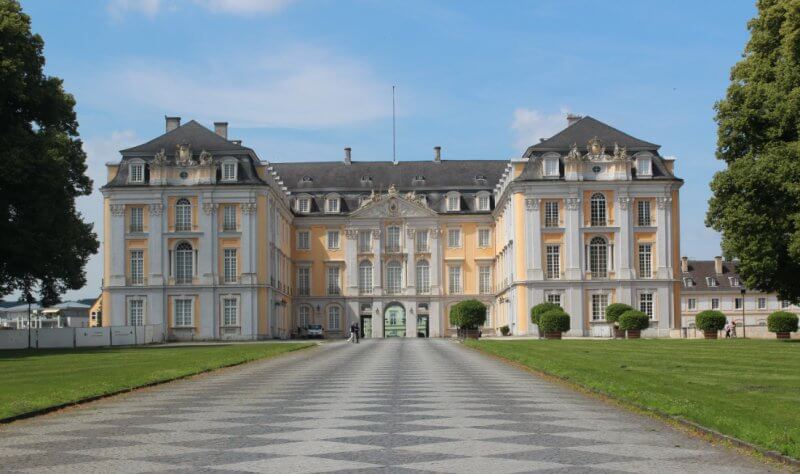
Augustusburg and Falkenlust are the earliest examples of Rococo architecture in Germany. They were built in the 18th century for the Elector of Cologne and Archbishop Clemens-August.
The luxurious Augustusburg Palace was the summer residence of the Archbishop. The first thing that catches the eye when you look at this building is its grand staircase. The Bishop’s private chambers and bathroom, the dining room, and the grand halls are all part of the richly decorated rooms that tourists can explore on organized tours. The interior is opulent, but it is the frescoes and the ornate domed ceilings that stand out.
Augustusburg Palace is surrounded by a landscaped English park with fountains, sculptures, and benches. A long, picturesque avenue leads through the park from Augustusburg Palace to Falkenlust Castle.
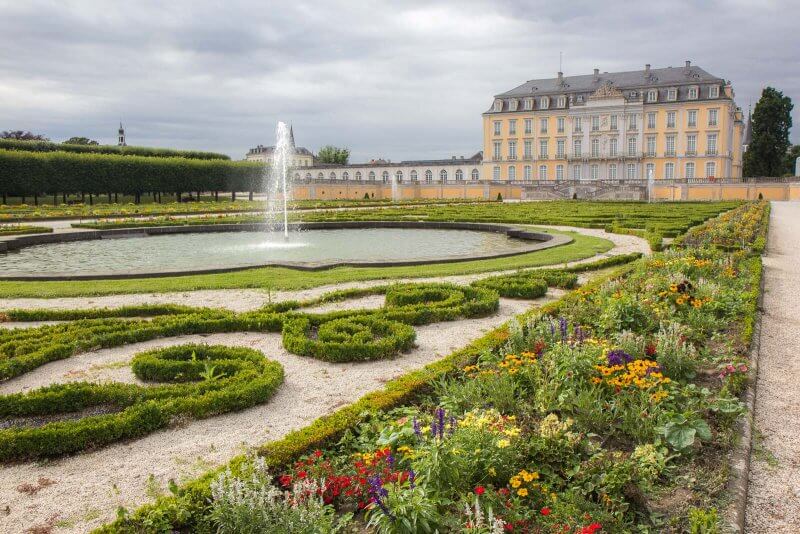
Falkenlust was built as a hunting castle, as Clemens-August was a great fan of falconry. The annexes that form the courtyard were previously occupied by the huntsmen and servants. Today, these rooms house an exhibition dedicated to falconry. Visitors can explore Falkenlust on their own, without a guide.
- Address of the attraction: Parkplatz, Max-Ernst-Allee, 50321 Bruhl, Germany
- Website: https://www.schlossbruehl.de/
- The complex is closed in December, January and February. The rest of the year, the castles are open at this time: Tuesday to Friday from 9: 00 to 16: 00, Saturday and Sunday from 10: 00 to 17: 00, Monday closed. The park is open for walking from 7: 00 to 21: 00, except on days with bad weather.
- Tickets to Augustusburg, which include a guided tour: for adults 9.5 €, for schoolchildren 3.5 €, for students 5 €. Tickets to Falkenlust Castle: for adults 7 €, for schoolchildren 2.5 €, for students 4 €. There is also a combined ticket to Augustusburg and Falkenlust: for adults 15 €, for schoolchildren 5 €, for students 7.5 €.
Conclusion
We have briefly told you about Cologne, the sights of this famous tourist city in Germany. Based on the photos and descriptions, you can choose the sights that interest you the most for your itinerary. Have a pleasant trip!

